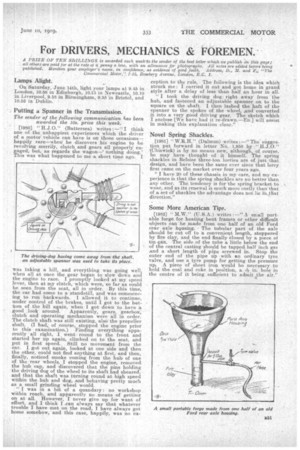For DRIVERS, MECHANICS & FOREMEN.
Page 23

If you've noticed an error in this article please click here to report it so we can fix it.
Lamps Alight
On Saturday, June 14th, light your lamps at 9.45 in London, 10.56 in Edinburgh, 10.13 in Newcastle, 10.10 in Liverpool, 9.58 in Birmingham, 9.55 in Bristol, and 10.52 in Dublin.
Putting a Spanner in the Transmission.
The sender of the following communication has been awarded the 108. prize this week.
[1980] "H.J.0." (Battersea) writes :—" I think one of the unhappiest experiences which the driver of a motor vehicle can have is on those occasions— happily rare—when he discovers his engine to be revolving merrily, clutch and gears all properly engaged, but, as regards the wagon—` nothing doing.' This was what happened to me a short time ago. I was taking a hill, and everything was going well, when all at once the gear began to slow down and the engine to race. I promptly looked at my speed lever, then at my clutch, which were, so far as could be seen from the seat, all in order. -By this time, the car had come to a standstill, and was commencing to run backwards. I allowed it to continue, under control of the brakes, until I got to the bettpm of the hill again, when I got down to have a good look around. Apparently, gears, gearbox, clutch and operating mechanism were all in order. The clutch shaft was still existing, also-the propeller shaft. (I had, of course, stopped the engine prior to this examination.) Finding everything apparently all right, I went round to the front and started her up again, climbed on to the seat, and put in first speed. Still no movement from the ear. I got out again, looked at one side and then the other, could not find anything at first, and then, finally, noticed smoke coming from the hub of one of the rear wheels. I stopped the engine, removed the hub cap, and discovered that the pins holding the driving dog of the wheel to its shaft had sheared, and that the shaft was turning round at high speed within the hub and dog, and behaving pretty much as a small grinding wheel would. "I was in a bit of a quandary : no workshop within reach, and apparently no means of getting on at all. However, I never give up for want of effort, and I think I can always say that whatever trouble I have met on the road, I have always got home somehow, and this case, happily, was no ex
ception to the rule. The following is the idea which struck me : I carried it out and got home in grand style after a delay of less than half an hour in all.
"I took the driving dog right away from the hub, and fastened an adjustable spanner on to the square on the shaft. I then lashed the haft of the spanner to the spokes of the wheel, and converted it into a very good driving gear. The sketch which I enclose [We have had it re-drawn.—En.j. will assist in making this explanation clear."
Novel Spring Shackles.
[1981] " W.R.H." (Dalmun) -writes :—" The' siiggestion put forward in letter No. 1,958 by "H.J.0." (Chiswick) is by no means new, although, of couyse, he may have thought of • it himself. The spring shackles in Belsize three-ton lorries are of just that design, and have been the same ever since that lorry first came. on the market over four years age.
"I have 20 of these chassis in my care, and my experience is that the spring shackles are no better than any other. The tendency, is for the spring bracket to wear, and as its renewal is much more cestly than that of a set of shackles the advantage does not lie in \that direction."
Some More American Tips.
[1982] " M.W." (U.S.A.) writes :—" A small portable forge for heating bent frames or other difficult objects can be made from one half of an old Ford rear axle housing. • The tubular part of the axle should be cut off to a convenient length, stoppered by fire clay, and the end finally ,closed by a piece ol tin can. The side of the tnbe a little below the end of the central casting should be tapped half inch gas and a short length of pipe screwed in. Stop the outer end of the pipe up •with an ordinary tyre valve, and use a tyre pump for getting the pressure upl. A piece of sheet iron would be necessary to hold the coal and coke in position, a Ain. hole in the centre of it being sufficient to admit the air.'
























